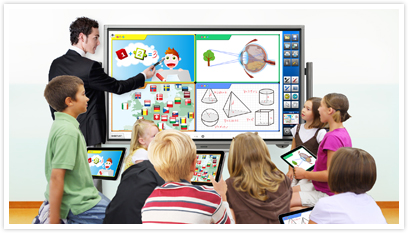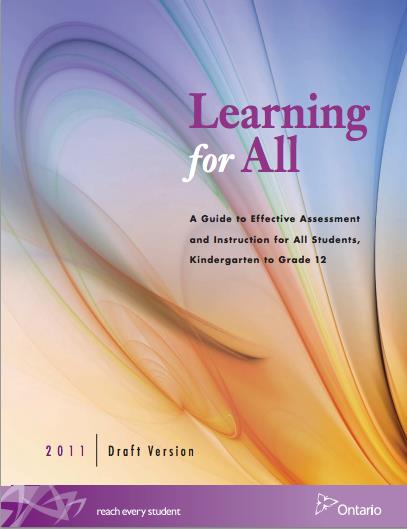 Add to favorites
Add to favoritesBy Written by Cindy Perras, M.Ed., OCT
Introduction

Assistive technology (AT) can be of tremendous benefit to students with learning disabilities (LDs); AT can compensate for a student's skills deficits, needs and/or area(s) of disability. The key to effective AT is finding the right match between the AT tool, the learning disabilities, and the task.
Students with LDs will most often require AT that assists with reading, language, organizational skills and processing information. Examples of AT include computers, mobile technology (tablets, smartphones, iPods, etc.), specialized software programs, scanners, and interactive whiteboards.
One type of AT that is becoming increasingly popular, as an instructional tool for educators who teach students with and without learning disabilities, is the interactive whiteboard (IWB). An IWB is a presentation device that interfaces with a computer; computer images are displayed on a touch-sensitive screen by a digital projector, where they can be seen and manipulated. Examples of commercially available IWBs include SMART Boards, MimioBoards, Polyvision IWBs, Epson’s BrightLink Pro, and the Promethean IWB. Various types of software and accessories are available for different IWBs.
How do whiteboards support the learning of students with LDs?
Students with LDs may require a variety of accommodations to access the curriculum, including technology. In the student’s Individual Education Plan (IEP), accommodations may include voice-to-text software (e.g. Dragon Naturally Speaking), text-to-speech software (e.g. Kurzweil), touch screen technology, and interactive whiteboards. As Universal Design for Learning (UDL) is strongly linked to technology, teachers can use the framework of UDL in the classroom, not just for students with learning disabilities, but for all students.
The Ministry’s resource document, Learning for All, notes the use of IWBs, in combination with UDL, as a recommended practice (Ministry of Education, 2011, p. 15):
Assistive Technology and UDL
The use of assistive technology, such as interactive whiteboards, for special education programs and classes provided a powerful starting point for focused discussions about equity, accessibility, and UDL.
Classroom teachers, special education resource teachers, and administrators were challenged and encouraged to think about the deployment of instructional tools to support students with special education needs in the context of school improvement planning. The resulting conversations often involved thinking about how technology might help to improve the achievement of both students with special education needs and students with a range of diverse learning needs in integrated settings.
Click here to access an introductory article on UDL, on the LD@school website.
It is important to understand how IWB technology supports the principles of UDL:
- Multiple means of engagement – IWBs are highly engaging for students and assist in sustaining interest and focus, which is especially helpful for students with ADHD;
- Multiple means of representation – IWBs provide educators with the ability to present information in a variety of linguistic and non-linguistic formats, e.g. graphics, audio, video clips, text, etc.; and
- Multiple means of action and expression – IWBs provide students with options to demonstrate their understanding of concepts and options to interact with and manipulate learning materials; for example, a student with fine motor challenges can use a special pen or finger on the board.
According to Learning for All, differentiated instruction (DI) is based on the idea that it is necessary to adapt instruction to suit students’ differing strengths, interests, learning styles, and readiness to learn. A key strategy in differentiated instruction is the use of flexible groupings, which allows educators to assign different tasks to students, individually or in small groups, based on strengths, interests, learning styles, or readiness. IWB technology allows educators to differentiate instruction and provide more individualized learning for all students, including those with LDs.
Lastly, the use of IWB technology promotes the inclusion of all students, with and without disabilities, through whole class, small group and individual instruction within the framework of UDL and DI.
Strategies for Students with LDs
The Blossom Learning Centre is a Canadian company, located in Richmond Hill, which provides online professional development for teachers. The resources section of their website provides the following strategies for using SMART Board technology:
Students with LDs in Reading (or dyslexia):
- By adding colorful text, video clips, animation and images into SMART Notebook lessons, educators can supplement their oral instructions which can make it easier for students with reading LDs to grasp key concepts.
- Educators can incorporate interactive phonics activities on the SMART Board interactive whiteboard into their lessons to help students build awareness of the letter sounds in words.
- Educators can use SMART Response systems with their SMART Board interactive whiteboard to give tests and quizzes and keep track of how well students are learning. Points that have not been understood properly can easily be identified and revisited.
- Classroom audio systems such as the SMART Audio system when used along side a SMART interactive whiteboard can help students hear the educator’s voice better.
- Educators can record processes on their SMART Board and then play them back to the class step by step, as many times as necessary.
- The SMART Notebook “Spotlight” feature allows educators to block off certain areas of text on the SMART Board which they might not want students to see just yet. This blocked off area can then be revealed as soon as students have processed the necessary information
Students with Reading Comprehension Difficulties:
- Enlarging text on the SMART Board to make it more legible
- Highlighting parts of the text with digital highlighter ink or the SMART pen tools
- Using the “Spotlight” feature to only reveal certain, relevant areas of text
- Integrating a SMART Document Cameras to display textbook pages and other hard copy literature on the SMART Board.
- Change text colors and backgrounds to make it more readable on the SMART Board.
Students with Fine Motor Difficulties:
- Students using the SMART Board can write on it using a finger, a pen from the SMART pen tray or a soft object like a tennis ball or hacky sack to practice their handwriting. The SMART Notebook software can then convert these handwritten letters to text using its handwriting recognition capabilities.
- Educators can show pre-lined paper templates on the SMART Board to make it easy for students to keep their writing on the SMART Board straight.
- Educators can help students with constructing letter forms by asking them to trace over built in alphabet letters and numerical symbols that are included with SMART Notebook Software
- Students can annotate over web pages, images and electronic documents on the SMART Board to practice their writing skills.
Students with ADHD:
- SMART Board interactive whiteboards can help teachers to teach students with ADHD by getting them more involved with the lesson, while keeping the lesson structured.
- Educators can allow students to manipulate the SMART Board screen with their hands, and interactive games and activities can be imbedded into SMART Notebook lessons to keep students engaged and focused.
- Features of SMART Notebook software like “reveal” and “spotlight” that keep from too much information being displayed on the SMART Board screen at once can help students with ADHD to focus on key areas, and educators can encourage students to highlight these key points and ideas on the SMART Board by drawing on the SMART Board screen in digital ink.
English Language Learners who may also have LDs:
- Audio can be embedded into SMART Notebook lessons to reinforce important or difficult learning concepts.
- Students can practice their writing on the SMART Board with the SMART pen tools, which is then converted to text and spell checked by SMART Notebook Software.
- Educators can use digital highlighter ink to emphasize certain things on the SMART Board screen. Notebook software features can be used to hide text and reveal it bit by bit.
- SMART Response systems can be integrated with SMART Board interactive whiteboard systems and used to gauge student comprehension of topics covered.
References
Ontario Ministry of Education. (2011). Learning for All – A Guide to Effective Assessment and Instruction for All Students, Kindergarten to Grade 12.
Related Resources on the LD@school Website
Additional Resources







